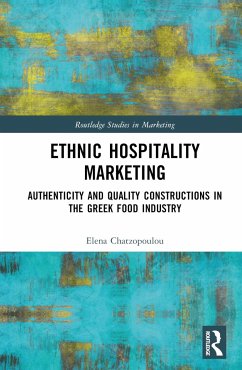Elena Chatzopoulou
Ethnic Hospitality Marketing
Authenticity and Quality Constructions in the Greek Food Industry
Elena Chatzopoulou
Ethnic Hospitality Marketing
Authenticity and Quality Constructions in the Greek Food Industry
- Gebundenes Buch
- Merkliste
- Auf die Merkliste
- Bewerten Bewerten
- Teilen
- Produkt teilen
- Produkterinnerung
- Produkterinnerung
Drawing on qualitative research methods, the book explores examples from the Greek food industry to analyse restaurateurs' and consumer constructed meanings of authenticity, how it is transmitted and received.
Andere Kunden interessierten sich auch für
![Ethnic Marketing Ethnic Marketing]() Guilherme PiresEthnic Marketing181,99 €
Guilherme PiresEthnic Marketing181,99 €![Winning the Advertising Game Winning the Advertising Game]() Sascha RaithelWinning the Advertising Game27,99 €
Sascha RaithelWinning the Advertising Game27,99 €![Fandom Analytics Fandom Analytics]() Michael LewisFandom Analytics23,99 €
Michael LewisFandom Analytics23,99 €![Introduction to Sport Marketing Introduction to Sport Marketing]() Aaron C T SmithIntroduction to Sport Marketing238,99 €
Aaron C T SmithIntroduction to Sport Marketing238,99 €![Social Media in the Fashion Industry Social Media in the Fashion Industry]() Patricia SanmiguelSocial Media in the Fashion Industry187,99 €
Patricia SanmiguelSocial Media in the Fashion Industry187,99 €![Consumer Behavior and Advertising Involvement Consumer Behavior and Advertising Involvement]() Edward P KrugmanConsumer Behavior and Advertising Involvement180,99 €
Edward P KrugmanConsumer Behavior and Advertising Involvement180,99 €![Brand Intimacy: A New Paradigm in Marketing Brand Intimacy: A New Paradigm in Marketing]() Mario NatarelliBrand Intimacy: A New Paradigm in Marketing20,99 €
Mario NatarelliBrand Intimacy: A New Paradigm in Marketing20,99 €-
-
-
Drawing on qualitative research methods, the book explores examples from the Greek food industry to analyse restaurateurs' and consumer constructed meanings of authenticity, how it is transmitted and received.
Hinweis: Dieser Artikel kann nur an eine deutsche Lieferadresse ausgeliefert werden.
Hinweis: Dieser Artikel kann nur an eine deutsche Lieferadresse ausgeliefert werden.
Produktdetails
- Produktdetails
- Verlag: Taylor & Francis
- Seitenzahl: 186
- Erscheinungstermin: 17. März 2023
- Englisch
- Abmessung: 234mm x 156mm x 13mm
- Gewicht: 463g
- ISBN-13: 9781032126722
- ISBN-10: 1032126728
- Artikelnr.: 66744132
- Herstellerkennzeichnung
- Libri GmbH
- Europaallee 1
- 36244 Bad Hersfeld
- gpsr@libri.de
- Verlag: Taylor & Francis
- Seitenzahl: 186
- Erscheinungstermin: 17. März 2023
- Englisch
- Abmessung: 234mm x 156mm x 13mm
- Gewicht: 463g
- ISBN-13: 9781032126722
- ISBN-10: 1032126728
- Artikelnr.: 66744132
- Herstellerkennzeichnung
- Libri GmbH
- Europaallee 1
- 36244 Bad Hersfeld
- gpsr@libri.de
Dr. Elena Chatzopoulou has served as an associate professor of marketing and digital marketing at universities in the United Kingdom and France, and also as (visiting) professor of marketing at IÉSEG, School of Management. Before joining academia, she worked as a marketing manager. Elena has supervised numerous theses of marketing students and has also provided consultancy services to companies with a focus on marketing, digital marketing and communication. She has taught in physical as well as in digital environments, at undergraduate and postgraduate levels. To name a few of her courses: digital consumer, e-business, branding, international marketing and integrated marketing communications, for which she received excellent student evaluations. During her academic tenure in the United Kingdom she was certified as a fellow of the Higher Education - UKPSF (D2). During her career she has received the teaching excellence award from the Academy of Marketing, the best paper award at the IFIP e-Business, e-Services and e-Society conference. She has also been awarded as an outstanding reviewer and for outstanding contribution to reviewing articles for publication by the journal Computers in Human Behavior.
Chapter 1: Introduction
1.1 Introduction
1.2 Authenticity and quality meanings
1.3 The aim: Setting food in the centre of our exploration
1.4 Food as a theoretical perspective
1.5 How can marketing influence food choices?
1.5.1 Marketing and consumer values
1.5.2 Marketing communications
1.6 What's the theoretical story (food glory)?
Chapter 2: Literature review
2.1 Introduction
2.2 Perspectives of authenticity
2.3 Food meanings and authenticity perceptions
2.4 Quality conventions and some theory behind
2.5 Self-identity and social identity: Can they influence food choices?
2.6 Ethnic identity and its influence upon food choices
2.7 Consumer culture and some theory behind
2.8 The influence of word of mouth (WOM) and e-word of mouth (eWOM) upon
consumers
2.9 Network building among food providers and consumers
2.10 What makes a successful restaurant?
2.11 Summary
Chapter 3: The Greek culinary culture and its health benefits
3.1 Introduction
3.2 The Greek culinary culture
3.3 The economic context: The restaurant sector in Greece over the last
years
3.4 Health benefits of the traditional Mediterranean diet
3.5 Summary
Chapter 4: Methodology
4.1 Introduction
4.2 Why conduct a qualitative study?
4.3 Interpretivism
4.4 Grounded theory
4.4.1 Constructivist strategy
4.4.2 Clusters
4.5 Semiotics and symbolic interactionism
4.6 Choice of data collection, sampling and data analysis methods
4.7 Interview guides (in-depth and cultural interviewing)
4.8 Projective technique (word association)
4.9 Inductive reasoning
4.10 Data analysis (coding stages and Nvivo)
4.11 Respondent validation
4.11.1 Constant comparison
4.11.2 Running an event: Presenting the findings to practitioners and
consumers
4.12 Ethical issues
4.13 Summary
Chapter 5: Restaurateurs' understanding of authenticity
5.1 Introduction
5.2 Restaurateurs' authenticity perceptions
5.2.1 Menu construction
5.2.2 Tradition (recipes from previous generations and not influenced by
other nations)
5.2.3 Traditional cooking (slow cooking technique, cooking from scratch)
5.2.4 Hummus and other controversial dishes (adaptation to the global
market)
5.2.5 Ingredients from the origin with or without PDO/PGI designation (e.g.
oil, olives, herbs, feta)
5.2.6 Wine from the origin
5.2.7 The staff
5.2.8 Music
5.2.9 Decoration / atmosphere
5.2.10 Traditional entertainment (e.g. smashing plates, traditional
dancing)
5.2.11 Indexical authenticity
5.2.12 Existential authenticity
5.3 Factors influencing the construction of authenticity
5.3.1 Identities and cultural familiarity
5.4 Summary
Chapter 6: Consumers' food choices and authenticity understanding
6.1 Introduction
6.2 Consumers' authenticity perceptions
6.2.1 Food and menu
6.2.2 Tradition
6.2.3 Hummus and other controversial dishes (adaptation to the market)
6.2.4 Ingredients and P.D.O. products (e.g. feta)
6.2.5 Atmosphere / decoration
6.2.6 Food quality
6.2.7 Taste
6.2.8 Staff
6.2.9 Music and entertainment
6.3 Factors influencing consumers' food choices
6.3.1 Nostalgia
6.3.2 The role of experiences
6.3.3 The restaurant owner
6.3.4 Identities
6.4 Summary
Chapter 7: The quality and authenticity network: identities, authenticity
perceptions and quality conventions
7.1 Introduction
7.2 An in-depth exploration of authenticity and its perceptions
7.3 Quality conventions
7.3.1 Quality conventions for ethnic restaurants
7.3.1.1 Inspirational category
7.3.1.2 Market category
7.3.1.3 Domestic category
7.3.2 Intersection of authenticity and quality
7.3.2.1 Pragmatic iconicity
7.3.2.2 Ancestral indexicality
7.3.2.3 Innovative iconicity
7.3.2.4 Intersection points of authenticity and quality
7.3.2.5 Authenticity convention and the identity factor
7.4 Structuring a network of restaurant owners and consumers: Their
communication and the word of mouth
7.4.1 Establishing a social network based on the word of mouth
7.4.2 Interessement
7.4.3 Word of mouth versus identity
7.5 Summary
Chapter 8: Discussion
8.1 Introduction
8.2 Quality and authenticity conventions of restaurant owners and consumers
within the communication network of ethnic restaurants
8.3 Summary
Chapter 9: Conclusions
9.1 Introduction
9.2 Summary of key findings related to research objectives
9.3 Theoretical implications
9.4 Practical implications
References
Appendix
1. Author's notes during the interviews with restaurateurs
2. Semi-structured interview schedule for ethnic restaurant managers/owners
3. Semi-structured interview schedule for consumers of Greek ethnic
restaurants
4. Menu 1 - Black font (Domestic oriented restaurant)
5. Menu 2 - Blue font (Market oriented restaurant)
1.1 Introduction
1.2 Authenticity and quality meanings
1.3 The aim: Setting food in the centre of our exploration
1.4 Food as a theoretical perspective
1.5 How can marketing influence food choices?
1.5.1 Marketing and consumer values
1.5.2 Marketing communications
1.6 What's the theoretical story (food glory)?
Chapter 2: Literature review
2.1 Introduction
2.2 Perspectives of authenticity
2.3 Food meanings and authenticity perceptions
2.4 Quality conventions and some theory behind
2.5 Self-identity and social identity: Can they influence food choices?
2.6 Ethnic identity and its influence upon food choices
2.7 Consumer culture and some theory behind
2.8 The influence of word of mouth (WOM) and e-word of mouth (eWOM) upon
consumers
2.9 Network building among food providers and consumers
2.10 What makes a successful restaurant?
2.11 Summary
Chapter 3: The Greek culinary culture and its health benefits
3.1 Introduction
3.2 The Greek culinary culture
3.3 The economic context: The restaurant sector in Greece over the last
years
3.4 Health benefits of the traditional Mediterranean diet
3.5 Summary
Chapter 4: Methodology
4.1 Introduction
4.2 Why conduct a qualitative study?
4.3 Interpretivism
4.4 Grounded theory
4.4.1 Constructivist strategy
4.4.2 Clusters
4.5 Semiotics and symbolic interactionism
4.6 Choice of data collection, sampling and data analysis methods
4.7 Interview guides (in-depth and cultural interviewing)
4.8 Projective technique (word association)
4.9 Inductive reasoning
4.10 Data analysis (coding stages and Nvivo)
4.11 Respondent validation
4.11.1 Constant comparison
4.11.2 Running an event: Presenting the findings to practitioners and
consumers
4.12 Ethical issues
4.13 Summary
Chapter 5: Restaurateurs' understanding of authenticity
5.1 Introduction
5.2 Restaurateurs' authenticity perceptions
5.2.1 Menu construction
5.2.2 Tradition (recipes from previous generations and not influenced by
other nations)
5.2.3 Traditional cooking (slow cooking technique, cooking from scratch)
5.2.4 Hummus and other controversial dishes (adaptation to the global
market)
5.2.5 Ingredients from the origin with or without PDO/PGI designation (e.g.
oil, olives, herbs, feta)
5.2.6 Wine from the origin
5.2.7 The staff
5.2.8 Music
5.2.9 Decoration / atmosphere
5.2.10 Traditional entertainment (e.g. smashing plates, traditional
dancing)
5.2.11 Indexical authenticity
5.2.12 Existential authenticity
5.3 Factors influencing the construction of authenticity
5.3.1 Identities and cultural familiarity
5.4 Summary
Chapter 6: Consumers' food choices and authenticity understanding
6.1 Introduction
6.2 Consumers' authenticity perceptions
6.2.1 Food and menu
6.2.2 Tradition
6.2.3 Hummus and other controversial dishes (adaptation to the market)
6.2.4 Ingredients and P.D.O. products (e.g. feta)
6.2.5 Atmosphere / decoration
6.2.6 Food quality
6.2.7 Taste
6.2.8 Staff
6.2.9 Music and entertainment
6.3 Factors influencing consumers' food choices
6.3.1 Nostalgia
6.3.2 The role of experiences
6.3.3 The restaurant owner
6.3.4 Identities
6.4 Summary
Chapter 7: The quality and authenticity network: identities, authenticity
perceptions and quality conventions
7.1 Introduction
7.2 An in-depth exploration of authenticity and its perceptions
7.3 Quality conventions
7.3.1 Quality conventions for ethnic restaurants
7.3.1.1 Inspirational category
7.3.1.2 Market category
7.3.1.3 Domestic category
7.3.2 Intersection of authenticity and quality
7.3.2.1 Pragmatic iconicity
7.3.2.2 Ancestral indexicality
7.3.2.3 Innovative iconicity
7.3.2.4 Intersection points of authenticity and quality
7.3.2.5 Authenticity convention and the identity factor
7.4 Structuring a network of restaurant owners and consumers: Their
communication and the word of mouth
7.4.1 Establishing a social network based on the word of mouth
7.4.2 Interessement
7.4.3 Word of mouth versus identity
7.5 Summary
Chapter 8: Discussion
8.1 Introduction
8.2 Quality and authenticity conventions of restaurant owners and consumers
within the communication network of ethnic restaurants
8.3 Summary
Chapter 9: Conclusions
9.1 Introduction
9.2 Summary of key findings related to research objectives
9.3 Theoretical implications
9.4 Practical implications
References
Appendix
1. Author's notes during the interviews with restaurateurs
2. Semi-structured interview schedule for ethnic restaurant managers/owners
3. Semi-structured interview schedule for consumers of Greek ethnic
restaurants
4. Menu 1 - Black font (Domestic oriented restaurant)
5. Menu 2 - Blue font (Market oriented restaurant)
Chapter 1: Introduction
1.1 Introduction
1.2 Authenticity and quality meanings
1.3 The aim: Setting food in the centre of our exploration
1.4 Food as a theoretical perspective
1.5 How can marketing influence food choices?
1.5.1 Marketing and consumer values
1.5.2 Marketing communications
1.6 What's the theoretical story (food glory)?
Chapter 2: Literature review
2.1 Introduction
2.2 Perspectives of authenticity
2.3 Food meanings and authenticity perceptions
2.4 Quality conventions and some theory behind
2.5 Self-identity and social identity: Can they influence food choices?
2.6 Ethnic identity and its influence upon food choices
2.7 Consumer culture and some theory behind
2.8 The influence of word of mouth (WOM) and e-word of mouth (eWOM) upon
consumers
2.9 Network building among food providers and consumers
2.10 What makes a successful restaurant?
2.11 Summary
Chapter 3: The Greek culinary culture and its health benefits
3.1 Introduction
3.2 The Greek culinary culture
3.3 The economic context: The restaurant sector in Greece over the last
years
3.4 Health benefits of the traditional Mediterranean diet
3.5 Summary
Chapter 4: Methodology
4.1 Introduction
4.2 Why conduct a qualitative study?
4.3 Interpretivism
4.4 Grounded theory
4.4.1 Constructivist strategy
4.4.2 Clusters
4.5 Semiotics and symbolic interactionism
4.6 Choice of data collection, sampling and data analysis methods
4.7 Interview guides (in-depth and cultural interviewing)
4.8 Projective technique (word association)
4.9 Inductive reasoning
4.10 Data analysis (coding stages and Nvivo)
4.11 Respondent validation
4.11.1 Constant comparison
4.11.2 Running an event: Presenting the findings to practitioners and
consumers
4.12 Ethical issues
4.13 Summary
Chapter 5: Restaurateurs' understanding of authenticity
5.1 Introduction
5.2 Restaurateurs' authenticity perceptions
5.2.1 Menu construction
5.2.2 Tradition (recipes from previous generations and not influenced by
other nations)
5.2.3 Traditional cooking (slow cooking technique, cooking from scratch)
5.2.4 Hummus and other controversial dishes (adaptation to the global
market)
5.2.5 Ingredients from the origin with or without PDO/PGI designation (e.g.
oil, olives, herbs, feta)
5.2.6 Wine from the origin
5.2.7 The staff
5.2.8 Music
5.2.9 Decoration / atmosphere
5.2.10 Traditional entertainment (e.g. smashing plates, traditional
dancing)
5.2.11 Indexical authenticity
5.2.12 Existential authenticity
5.3 Factors influencing the construction of authenticity
5.3.1 Identities and cultural familiarity
5.4 Summary
Chapter 6: Consumers' food choices and authenticity understanding
6.1 Introduction
6.2 Consumers' authenticity perceptions
6.2.1 Food and menu
6.2.2 Tradition
6.2.3 Hummus and other controversial dishes (adaptation to the market)
6.2.4 Ingredients and P.D.O. products (e.g. feta)
6.2.5 Atmosphere / decoration
6.2.6 Food quality
6.2.7 Taste
6.2.8 Staff
6.2.9 Music and entertainment
6.3 Factors influencing consumers' food choices
6.3.1 Nostalgia
6.3.2 The role of experiences
6.3.3 The restaurant owner
6.3.4 Identities
6.4 Summary
Chapter 7: The quality and authenticity network: identities, authenticity
perceptions and quality conventions
7.1 Introduction
7.2 An in-depth exploration of authenticity and its perceptions
7.3 Quality conventions
7.3.1 Quality conventions for ethnic restaurants
7.3.1.1 Inspirational category
7.3.1.2 Market category
7.3.1.3 Domestic category
7.3.2 Intersection of authenticity and quality
7.3.2.1 Pragmatic iconicity
7.3.2.2 Ancestral indexicality
7.3.2.3 Innovative iconicity
7.3.2.4 Intersection points of authenticity and quality
7.3.2.5 Authenticity convention and the identity factor
7.4 Structuring a network of restaurant owners and consumers: Their
communication and the word of mouth
7.4.1 Establishing a social network based on the word of mouth
7.4.2 Interessement
7.4.3 Word of mouth versus identity
7.5 Summary
Chapter 8: Discussion
8.1 Introduction
8.2 Quality and authenticity conventions of restaurant owners and consumers
within the communication network of ethnic restaurants
8.3 Summary
Chapter 9: Conclusions
9.1 Introduction
9.2 Summary of key findings related to research objectives
9.3 Theoretical implications
9.4 Practical implications
References
Appendix
1. Author's notes during the interviews with restaurateurs
2. Semi-structured interview schedule for ethnic restaurant managers/owners
3. Semi-structured interview schedule for consumers of Greek ethnic
restaurants
4. Menu 1 - Black font (Domestic oriented restaurant)
5. Menu 2 - Blue font (Market oriented restaurant)
1.1 Introduction
1.2 Authenticity and quality meanings
1.3 The aim: Setting food in the centre of our exploration
1.4 Food as a theoretical perspective
1.5 How can marketing influence food choices?
1.5.1 Marketing and consumer values
1.5.2 Marketing communications
1.6 What's the theoretical story (food glory)?
Chapter 2: Literature review
2.1 Introduction
2.2 Perspectives of authenticity
2.3 Food meanings and authenticity perceptions
2.4 Quality conventions and some theory behind
2.5 Self-identity and social identity: Can they influence food choices?
2.6 Ethnic identity and its influence upon food choices
2.7 Consumer culture and some theory behind
2.8 The influence of word of mouth (WOM) and e-word of mouth (eWOM) upon
consumers
2.9 Network building among food providers and consumers
2.10 What makes a successful restaurant?
2.11 Summary
Chapter 3: The Greek culinary culture and its health benefits
3.1 Introduction
3.2 The Greek culinary culture
3.3 The economic context: The restaurant sector in Greece over the last
years
3.4 Health benefits of the traditional Mediterranean diet
3.5 Summary
Chapter 4: Methodology
4.1 Introduction
4.2 Why conduct a qualitative study?
4.3 Interpretivism
4.4 Grounded theory
4.4.1 Constructivist strategy
4.4.2 Clusters
4.5 Semiotics and symbolic interactionism
4.6 Choice of data collection, sampling and data analysis methods
4.7 Interview guides (in-depth and cultural interviewing)
4.8 Projective technique (word association)
4.9 Inductive reasoning
4.10 Data analysis (coding stages and Nvivo)
4.11 Respondent validation
4.11.1 Constant comparison
4.11.2 Running an event: Presenting the findings to practitioners and
consumers
4.12 Ethical issues
4.13 Summary
Chapter 5: Restaurateurs' understanding of authenticity
5.1 Introduction
5.2 Restaurateurs' authenticity perceptions
5.2.1 Menu construction
5.2.2 Tradition (recipes from previous generations and not influenced by
other nations)
5.2.3 Traditional cooking (slow cooking technique, cooking from scratch)
5.2.4 Hummus and other controversial dishes (adaptation to the global
market)
5.2.5 Ingredients from the origin with or without PDO/PGI designation (e.g.
oil, olives, herbs, feta)
5.2.6 Wine from the origin
5.2.7 The staff
5.2.8 Music
5.2.9 Decoration / atmosphere
5.2.10 Traditional entertainment (e.g. smashing plates, traditional
dancing)
5.2.11 Indexical authenticity
5.2.12 Existential authenticity
5.3 Factors influencing the construction of authenticity
5.3.1 Identities and cultural familiarity
5.4 Summary
Chapter 6: Consumers' food choices and authenticity understanding
6.1 Introduction
6.2 Consumers' authenticity perceptions
6.2.1 Food and menu
6.2.2 Tradition
6.2.3 Hummus and other controversial dishes (adaptation to the market)
6.2.4 Ingredients and P.D.O. products (e.g. feta)
6.2.5 Atmosphere / decoration
6.2.6 Food quality
6.2.7 Taste
6.2.8 Staff
6.2.9 Music and entertainment
6.3 Factors influencing consumers' food choices
6.3.1 Nostalgia
6.3.2 The role of experiences
6.3.3 The restaurant owner
6.3.4 Identities
6.4 Summary
Chapter 7: The quality and authenticity network: identities, authenticity
perceptions and quality conventions
7.1 Introduction
7.2 An in-depth exploration of authenticity and its perceptions
7.3 Quality conventions
7.3.1 Quality conventions for ethnic restaurants
7.3.1.1 Inspirational category
7.3.1.2 Market category
7.3.1.3 Domestic category
7.3.2 Intersection of authenticity and quality
7.3.2.1 Pragmatic iconicity
7.3.2.2 Ancestral indexicality
7.3.2.3 Innovative iconicity
7.3.2.4 Intersection points of authenticity and quality
7.3.2.5 Authenticity convention and the identity factor
7.4 Structuring a network of restaurant owners and consumers: Their
communication and the word of mouth
7.4.1 Establishing a social network based on the word of mouth
7.4.2 Interessement
7.4.3 Word of mouth versus identity
7.5 Summary
Chapter 8: Discussion
8.1 Introduction
8.2 Quality and authenticity conventions of restaurant owners and consumers
within the communication network of ethnic restaurants
8.3 Summary
Chapter 9: Conclusions
9.1 Introduction
9.2 Summary of key findings related to research objectives
9.3 Theoretical implications
9.4 Practical implications
References
Appendix
1. Author's notes during the interviews with restaurateurs
2. Semi-structured interview schedule for ethnic restaurant managers/owners
3. Semi-structured interview schedule for consumers of Greek ethnic
restaurants
4. Menu 1 - Black font (Domestic oriented restaurant)
5. Menu 2 - Blue font (Market oriented restaurant)








